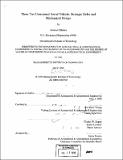| dc.contributor.advisor | Peter Young. | en_US |
| dc.contributor.author | Chhabra, Alankar, 1976- | en_US |
| dc.contributor.other | Massachusetts Institute of Technology. Dept. of Aeronautics and Astronautics. | en_US |
| dc.date.accessioned | 2009-12-10T19:09:17Z | |
| dc.date.available | 2009-12-10T19:09:17Z | |
| dc.date.copyright | 1999 | en_US |
| dc.date.issued | 1999 | en_US |
| dc.identifier.uri | http://hdl.handle.net/1721.1/50079 | |
| dc.description | Thesis (M.Eng.)--Massachusetts Institute of Technology, Dept. of Aeronautics and Astronautics, 1999. | en_US |
| dc.description | Includes bibliographical references (leaves 70-71). | en_US |
| dc.description.abstract | This thesis documents the systems approach, strategic role and mechanical design elements of a three-tier unmanned aerial vehicle prototype being developed by the MIT/Draper Technology Partnership. This parent-child concept incorporates three classes of Unmanned Aerial Vehicles (UAVs). A parent vehicle of 3.4-meter wingspan is maintained at the mother level while a mini-vehicle of one-meter wingspan and micro vehicles of six inches maximum dimension make up its children. Because of this hierarchical structure, the aerial system designed and developed has been named the Parent-Child Unmanned Aerial Vehicle (PCUAV). Two major components of the PCUAV system are covered extensively in this document. The first component consists of the systems engineering approach used in the research and development of the vehicle system. This section presents why a PCUAV system is needed and what strategic roles are to be performed by the vehicle. The PCUAV is a novel concept designed to be used as an intelligence-gathering tool for platoon-sized units, Navy ships, and numerous commercial applications. It is designed for incorporation into both military and commercial missions and is to be deployed in both urban and suburban settings. Such a system will perform missions in reconnaissance, bomb damage assessment, micro aerial vehicle deployment and communication, and other unspecified applications. This UAV is designed to be two-man portable, allow short takeoff and landing, and be adaptable to various types of environmental conditions. The second component of this document consists of the preliminary vehicle design and development. This component that takes the concept to a preliminary design stage will lay the foundation for a future design and build of a PCUAV. The prototype vehicle described in this thesis is designed to verify the PCUAV systems concept and to study its mechanical structure and layout. Its development and design is part of a two-year joint venture by Massachusetts Institute of Technology and the Charles Stark Draper Laboratory. | en_US |
| dc.description.statementofresponsibility | by Alankar Chhabra. | en_US |
| dc.format.extent | 85 leaves | en_US |
| dc.language.iso | eng | en_US |
| dc.publisher | Massachusetts Institute of Technology | en_US |
| dc.rights | M.I.T. theses are protected by
copyright. They may be viewed from this source for any purpose, but
reproduction or distribution in any format is prohibited without written
permission. See provided URL for inquiries about permission. | en_US |
| dc.rights.uri | http://dspace.mit.edu/handle/1721.1/7582 | en_US |
| dc.subject | Aeronautics and Astronautics. | en_US |
| dc.title | Three tier unmanned aerial vehicle : strategic roles and mechanical design | en_US |
| dc.title.alternative | Three tier UAV | en_US |
| dc.type | Thesis | en_US |
| dc.description.degree | M.Eng. | en_US |
| dc.contributor.department | Massachusetts Institute of Technology. Department of Aeronautics and Astronautics | en_US |
| dc.identifier.oclc | 43596239 | en_US |
